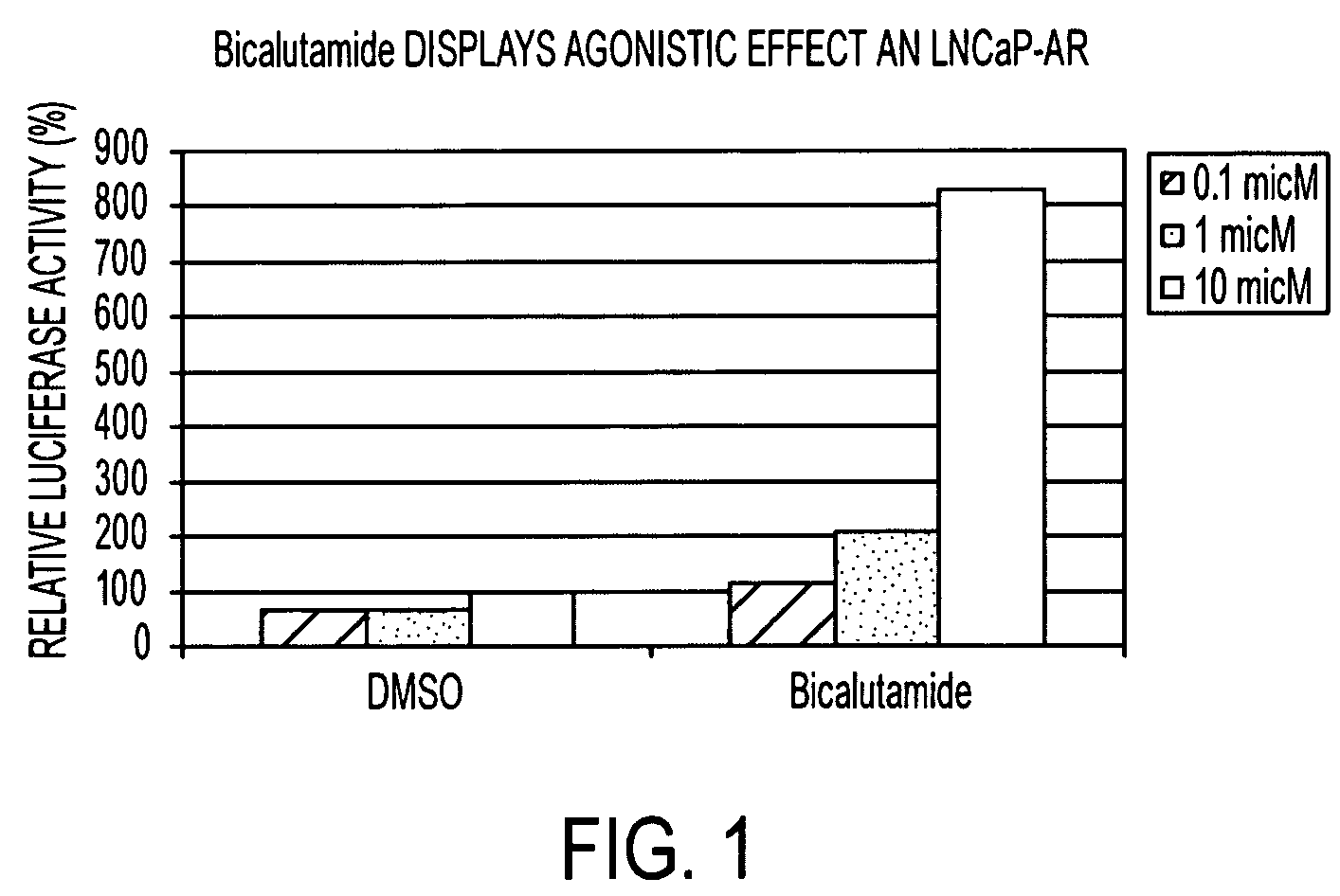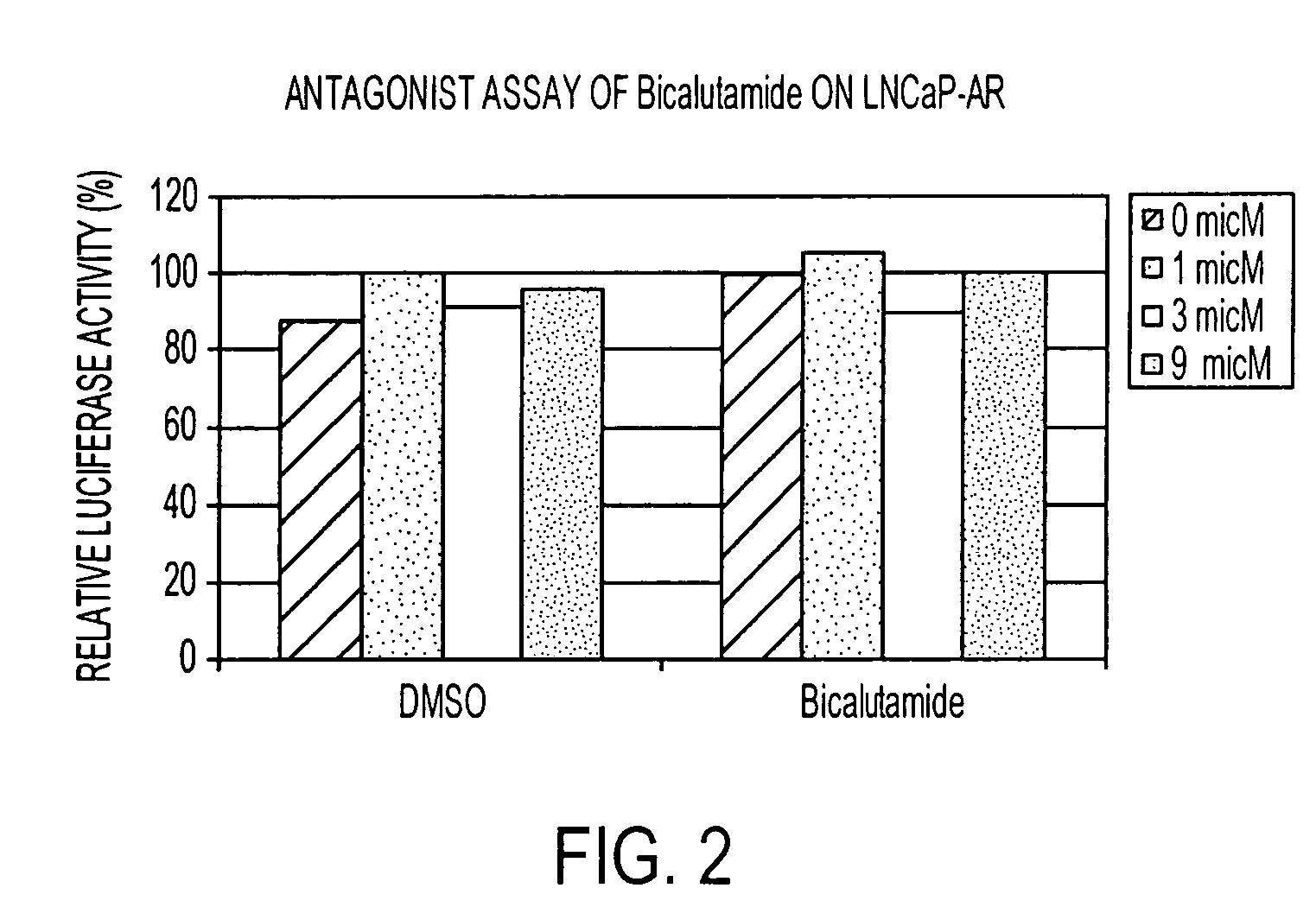Diarylhydantoin compounds
a technology of diarylhydantoin and compounds, which is applied in the field of diarylhydantoin compounds, can solve the problems of inability to inability to readily envision other specific compounds, and inability to fully suppress ar when cancer becomes hormone refractory
- Summary
- Abstract
- Description
- Claims
- Application Information
AI Technical Summary
Benefits of technology
Problems solved by technology
Method used
Image
Examples
example 1
4-isothiocyanato-2-trifluoromethylbenzonitrile, (1a)
[0110]4-Amino-2-trifluoromethylbenzonitrile, (2.23 g, 12 mmol) was added portionwise over 15 minutes into the well-stirred heterogeneous mixture of thiophosgene (1 ml, 13 mmol) in water (22 ml) at room temperature. Stirring was continued for an additional 1 h. The reaction medium was extracted with chloroform (3×15 ml). The combined organic phase was dried over MgSO4 and evaporated to dryness under reduced pressure to yield desired product, 4-isothiocyanato-2 -trifluoromethylbenzonitrile, (1a), as brownish solid and was used as such for the next step (2.72 g, 11.9 mmol, 99%).
example 2
2-1). (4-aminophenyl)carbamic acid tert-butyl ester, (2a)
[0111]An aqueous solution of potassium carbonate (1.52 g, 11 mmol in 5 ml of water) was added to a solution of 1,4-diaminobenzene (3.24 g, 30 mmol) in THF (30 ml) and DMF (10 ml). To this mixture was added di-tert-butyl pyrocarbonate, Boc2O (2.18 g, 10 mmol), dropwise over 0.5 h. The reaction mixture was stirred for an additional 4 h at room temperature. The mixture was then poured into cold water (40 ml) and extracted with chloroform (3×50 ml). The combined organic phase was dried over MgSO4 and concentrated to yield a brown residue which was subjected to flash chromatography (dichloromethane / acetone, 4:1) to afford (4-aminophenyl)carbamic acid tert-butyl ester, (2a) as a yellow solid (1.98 g, 9.5 mmol, 95%) (yield based on Boc2O).
2-2). {4-[(1-cyano-1-methylethyl)amino]phenyl}carbamic acid tert-butyl ester, 2b
[0112]The mixture of 2a (0.83 g, 4 mmol), acetone cyanohydrin (4 ml) and MgSO4 (2 g) was heated to 80° C. and stirred ...
example 3
3-1). 2-(4-hydroxyphenylamino)-2-methylpropanenitrile, 3a
[0120]A mixture of 4-aminophenol (1.09 g, 10 mmol), acetone cyanohydrin (10 ml) and MgSO4 (2 g) was heated to 80° C. and stirred for 4 h. After concentration of the medium under vacuum, compound 3a was crystallized from water (20 ml). The solid was filtered and dried to yield 2-(4-hydroxyphenylamino)-2-methylpropanenitrile, 3a (1.69 g, 9.6 mmol, 96%).
3-2). 4-[3-(4-hydroxyphenyl)-5-imino-4,4 -dimethyl-2-thioxoimidazolidin-1-yl]-2-trifluoromethylbenzonitrile, 3b
[0121]Triethylamine (0.101 g, 1 mmol) was added to a solution of 1a (0.456 g, 2 mmol) and 3a (0.352 g, 2 mmol) in dry THF (5 ml). The reaction mixture was stirred at 0° C. for 48 h and then concentrated to yield a dark residue which was subjected to flash chromatography (dichloromethane / acetone, 85:15) to afford 4-[3-(4-hydroxyphenyl)-5-imino-4,4-dimethyl-2-thioxoimidazolidin-1-yl]-2-trifluoromethylbenzonitrile, 3b (0.274 g, 0.68 mmol, 34%).
3-3). 4-[3-(4-hydroxyphenyl)-4,...
PUM
| Property | Measurement | Unit |
|---|---|---|
| weight | aaaaa | aaaaa |
| weight | aaaaa | aaaaa |
| weight | aaaaa | aaaaa |
Abstract
Description
Claims
Application Information
 Login to View More
Login to View More - R&D
- Intellectual Property
- Life Sciences
- Materials
- Tech Scout
- Unparalleled Data Quality
- Higher Quality Content
- 60% Fewer Hallucinations
Browse by: Latest US Patents, China's latest patents, Technical Efficacy Thesaurus, Application Domain, Technology Topic, Popular Technical Reports.
© 2025 PatSnap. All rights reserved.Legal|Privacy policy|Modern Slavery Act Transparency Statement|Sitemap|About US| Contact US: help@patsnap.com



